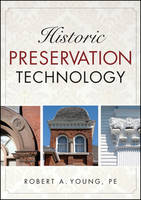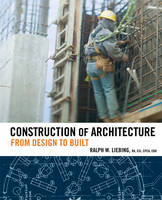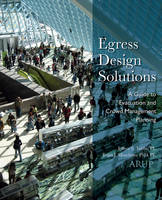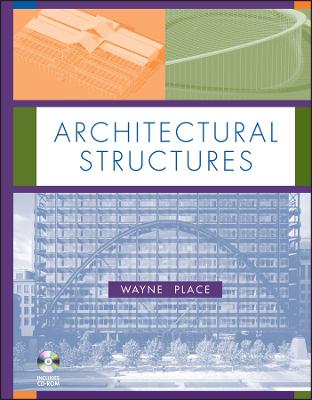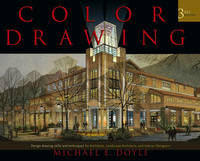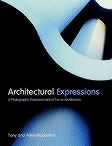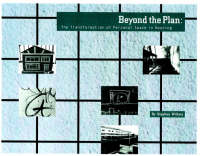Structural Design
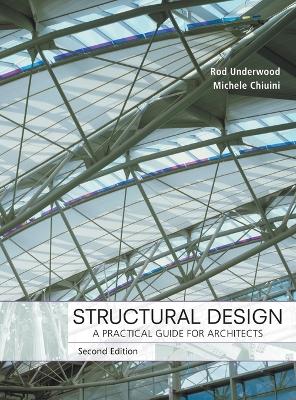 -15%
portes grátis
-15%
portes grátis
Structural Design
A Practical Guide for Architects
Underwood, James R.; Chiuini, Michele
John Wiley & Sons Inc
07/2007
816
Dura
Inglês
9780471789048
15 a 20 dias
2508
Descrição não disponível.
Preface. In the Beginning: The Premise.
Chapter 1: Introduction: Understanding Loads.
1.1 Loads.
1.2 Tributary Areas.
1.3 Lateral Loads-Wind and Earthquakes.
1.4 Lateral Loads: Wind
1.5 Lateral Loads: Earthquake.
1.6 Loading Conditions.
Chapter 2: Load and Resistance Factor Design.
2.1 Load Combinations.
2.2 Resistance Factors.
2.3 Working Stress versus LFRD Design.
2.4 Elastic Section Modulus and Plastic Section Modulus.
2.5 Shape Factor.
PART ONE: STEEL.
Chapter 3: Materials and Properties.
3.1 Structural Properties of Steel.
3.2 Allowable Stress.
3.3 Yield Stress.
3.4 Standard Shapes.
3.5 Fire Considerations.
3.6 Surface Finishes.
Chapter 4: Structural Elements and Systems.
4.1 Member Types.
4.2 System Selection.
4.3 Low-Rise Frame Systems.
4.4 Medium- and High-Rise Systems.
4.5 Architectural Considerations.
SECTION 1: STEEL BENDING SYSTEMS.
Chapter 5: Preengineered Systems.
5.1 Open-Web Steel Joist.
5.2 Steel Decks.
Chapter 6: Steel Beams.
6.1 Beam Theory.
6.2 Beams in Structural Systems.
Chapter 7: Lateral Stability in Beams.
7.1 Conditions of Stability.
Chapter 8: Supports.
8.1 Bearing Plates for Beams and Columns.
8.2 Design of Bearing Plates.
8.3 Column Base Plates.
8.4 Design of Column Base Plates.
Chapter 9: Web Yielding and Crippling.
9.1 Localized Failure of Components.
Chapter 10: Built-Up Beams.
10.1 Built-Up Sections.
10.2 Connection and Length of Cover Plates.
10.3 Holes in the Web and in the Flanges.
SECTION 2: STEEL AXIALLY LOADED SYSTEMS.
Chapter 11: Columns.
11.1 Column Theory.
11.2 Built-Up Columns.
11.3 Columns with Unequal Unbraced Lengths.
Chapter 12: Tension Members.
12.1 Types of Tensions Members.
12.2 Basic Design.
12.3 Connection of Tension Members.
12.4 Suspension Structures.
SECTION 3: STEEL COMBINED SYSTEMS.
Chapter 13: Combined Axial Loading and Bending.
13.1 Basic Considerations and Procedure.
13.2 Sloped Beams.
Chapter 14: Trusses.
14.1 General Comments.
14.2 Design Considerations.
14.3 Truss Analysis.
SECTION 4: STEEL CONNECTIONS.
Chapter 15: Bolted Connections.
15.1 Engineering Principles.
15.2 Types of Bolted Connections.
15.3 Bolts.
15.4 Design of Connections.
Chapter 16: Welded Connections.
16.1 Welding and Types of Welded Joints.
16.2 Stresses in Welds.
16.3 Minimum and Maximum Weld Considerations.
16.4 Framed Beam Connections.
PART TWO: WOOD.
Chapter 17: Materials and Properties.
17.1 Physical Properties.
17.2 Density and Weight of Wood.
17.3 Protection from Decay and Fire.
17.4 Design Values.
17.5 Size Classifications.
17.6 Adjustment Factors.
17.7 Engineered Wood Products.
Chapter 18: Wood Structures in Architecture.
18.1 Construction and Architectural Philosophies.
18.2 The Architect's Responsibility in Structural Wood Design.
18.3 Selection and Configuration of Wood Systems.
18.4 Framing System.
18.5 Long-Span Systems.
18.6 Bracing.
SECTION 1: WOOD BENDING SYSTEMS.
Chapter 19: Bending Members: Floor and Roof Systems.
19.1 Floor Framing.
19.2 Joist Design.
19.3 Adjustment Factors.
19.4 Engineered Joist.
19.5 Subfloors.
19.6 Fire Protection and Sound Insulation.
19.7 Roof Construction.
19.8 Bearing and Stress Concentration.
19.9 Notched Bending Members.
Chapter 20: Sheathing and Diaphragm Design.
20.1 Diaphragm Construction.
20.2 Shear Walls.
20.3 Composite Bending Members.
20.4 Plywood Structural Properties.
20.5 Box Beam Design.
Chapter 21: Timber and Laminated Timber Beams.
21.1 Timber Beams..
21.2 Built-Up Beams.
21.3 Laminated Timber Beams.
21.4 Design of Laminated Timber Beams.
21.5 Types of Structures Using Glulam.
SECTION 2: WOOD AXIALLY LOADED MEMBERS.
Chapter 22: Compression and Tension Members.
22.1 Types of Compression and Tension Members.
22.2 Design Procedure for Solid Columns.
22.3 Built-Up and Spaced Column Design.
22.4 Tension Members.
22.5 Axial Compression and Bending.
22.6 Axial Tension and Bending.
SECTION 3: WOOD COMBINED SYSTEMS.
Chapter 23: Timber Truss Design.
23.1 Truss Types.
23.2 Deflection and Camber.
23.3 General Design Procedure.
Chapter 24: Arches, Vaults and Domes.
24.1 Two- and Three-Hinged Arches.
24.2 Preliminary Design of Laminated Timber Arches.
24.3 Construction of Timber Arches.
24.4 Domes and Vaulted Roofs.
SECTION 4: WOOD CONNECTIONS.
Chapter 25: Connections.
25.1 Connecting Wood Members.
25.2 Nails and Spikes.
25.3 Adhesives.
25.4 Glue Line Stresses: Rolling Shear.
25.5 Bolts.
25.6 Lag screws.
25.7 Wood Screws.
25.8 Split Ring and Shear Plate Connectors.
25.9 Design of Shear Plate and Split Ring Connections.
SECTION 5: WOOD SPECIAL SYSTEMS.
Chapter 26: Permanent Wood Foundations.
26.1 Types of Wood Foundations.
26.2 Permanent Wood Foundation.
26.3 Design of Footing Foundations.
26.4 Basement Walls.
PART THREE: REINFORCED CONCRETE (R/C).
Chapter 27: Materials and Properties.
27.1 Structural Concrete Materials.
27.2 Structural Concrete Properties.
27.3 Reinforcing Steel.
27.4 Fiber-Rreinforced Concrete.
27.5 Placement of Concrete.
Chapter 28: Reinforced Concrete in Architecture.
28.1 Structural Forms.
28.2 Structural Design Issues.
28.3 System Selection.
SECTION 1: R/C BENDING MEMBERS.
Chapter 29: Beams Strength Theory.
29.1 Stress and Strain in Flexural Members.
29.2 Beam Design Formula.
Chapter 30: Beam Design.
30.1 Design for Bending Moment.
30.2 Development of Reinforcement.
Chapter 31: Shear in Beams.
31.1 Shear Strength of Concrete.
31.2 Design of Shear Reinforcement.
Chapter 32: Slabs.
32.1 Flat Spanning Systems.
32.2 Flat Slab Design.
32.3 Slab on Grade.
32.4 Composite Sections.
Chapter 33: Deflection.
33..1 Creep and Deflection.
33.2 Deflection Computations.
Chapter 34: Footings.
34.1 Foundation Design Criteria.
34.2 Footings.
34.3 Design Procedure of Footings.
34.4 Peripheral Shear.
34.5 Rectangular Footings.
34.6 Simple Wall Footings.
SECTION 2: R/C AXIALLY LOADED MEMBERS.
Chapter 35: Columns.
35.1 Construction of R/C Columns.
35.2 Design Method.
Chapter 36: Walls.
36.1 Concrete Wall Types.
36.2 Design Requirements for Vertical Loads.
36.3 Walls Designed as Compression Members.
36.4 Horizontal Forces in Basement Walls.
36.5 Retaining Walls.
36.6 Shear Walls.
SECTION 3: R/C CONNECTIONS.
Chapter 37: Connections.
37.1 Connections of Footings and Vertical Structure.
37.2 Anchors.
37.3 Bearing Pressures.
37.4 Concrete Supports.
SECTION 4: R/C SPECIAL SYSTEMS.
Chapter 38: Prestressed and Precast Concrete.
38.1 Prestressed Concrete.
38.2 Construction Techniques.
38.3 Precast Concrete Shapes.
PART FOUR: MASONRY.
Chapter 39: Materials and Properties.
39.1 Masonry Units.
39.2 Mortar and Grout.
39.3 Mortar Strength.
39.4 Construction.
39.5 Design Requirements.
39.6 Expansion/Control Joints and Reinforcing.
39.7 Flashing.
Chapter 40: Structural Systems.
40.1 Masonry Construction.
40.2 System Selection.
40.3 Masonry Systems.
SECTION 1: MASONRY AXIALLY LOADED MEMBERS.
Chapter 41: Empirical Design of Walls.
41.1 Limitations of Empirical Design.
41.2 Working Stress.
41.3 Lateral Stability and Shear Walls.
41.4 Unsupported Height or Length.
41.5 Wall Thickness.
Chapter 42: Allowable Stress Method.
42.1 Unreinforced Masonry.
42.2 Bearing and Concentrated Loads.
42.3 Design of Shear Walls.
42.4 Reinforced Walls.
42.5 Column and Pilaster Construction.
42.6 Column Design.
Appendix A: Commonly Used Tables and Constants.
Appendix B: Conversion Factors from U.S. Customary Units to SI Metric Units.
Bibliography.
References.
Illustration and Table Credits.
Index.
Chapter 1: Introduction: Understanding Loads.
1.1 Loads.
1.2 Tributary Areas.
1.3 Lateral Loads-Wind and Earthquakes.
1.4 Lateral Loads: Wind
1.5 Lateral Loads: Earthquake.
1.6 Loading Conditions.
Chapter 2: Load and Resistance Factor Design.
2.1 Load Combinations.
2.2 Resistance Factors.
2.3 Working Stress versus LFRD Design.
2.4 Elastic Section Modulus and Plastic Section Modulus.
2.5 Shape Factor.
PART ONE: STEEL.
Chapter 3: Materials and Properties.
3.1 Structural Properties of Steel.
3.2 Allowable Stress.
3.3 Yield Stress.
3.4 Standard Shapes.
3.5 Fire Considerations.
3.6 Surface Finishes.
Chapter 4: Structural Elements and Systems.
4.1 Member Types.
4.2 System Selection.
4.3 Low-Rise Frame Systems.
4.4 Medium- and High-Rise Systems.
4.5 Architectural Considerations.
SECTION 1: STEEL BENDING SYSTEMS.
Chapter 5: Preengineered Systems.
5.1 Open-Web Steel Joist.
5.2 Steel Decks.
Chapter 6: Steel Beams.
6.1 Beam Theory.
6.2 Beams in Structural Systems.
Chapter 7: Lateral Stability in Beams.
7.1 Conditions of Stability.
Chapter 8: Supports.
8.1 Bearing Plates for Beams and Columns.
8.2 Design of Bearing Plates.
8.3 Column Base Plates.
8.4 Design of Column Base Plates.
Chapter 9: Web Yielding and Crippling.
9.1 Localized Failure of Components.
Chapter 10: Built-Up Beams.
10.1 Built-Up Sections.
10.2 Connection and Length of Cover Plates.
10.3 Holes in the Web and in the Flanges.
SECTION 2: STEEL AXIALLY LOADED SYSTEMS.
Chapter 11: Columns.
11.1 Column Theory.
11.2 Built-Up Columns.
11.3 Columns with Unequal Unbraced Lengths.
Chapter 12: Tension Members.
12.1 Types of Tensions Members.
12.2 Basic Design.
12.3 Connection of Tension Members.
12.4 Suspension Structures.
SECTION 3: STEEL COMBINED SYSTEMS.
Chapter 13: Combined Axial Loading and Bending.
13.1 Basic Considerations and Procedure.
13.2 Sloped Beams.
Chapter 14: Trusses.
14.1 General Comments.
14.2 Design Considerations.
14.3 Truss Analysis.
SECTION 4: STEEL CONNECTIONS.
Chapter 15: Bolted Connections.
15.1 Engineering Principles.
15.2 Types of Bolted Connections.
15.3 Bolts.
15.4 Design of Connections.
Chapter 16: Welded Connections.
16.1 Welding and Types of Welded Joints.
16.2 Stresses in Welds.
16.3 Minimum and Maximum Weld Considerations.
16.4 Framed Beam Connections.
PART TWO: WOOD.
Chapter 17: Materials and Properties.
17.1 Physical Properties.
17.2 Density and Weight of Wood.
17.3 Protection from Decay and Fire.
17.4 Design Values.
17.5 Size Classifications.
17.6 Adjustment Factors.
17.7 Engineered Wood Products.
Chapter 18: Wood Structures in Architecture.
18.1 Construction and Architectural Philosophies.
18.2 The Architect's Responsibility in Structural Wood Design.
18.3 Selection and Configuration of Wood Systems.
18.4 Framing System.
18.5 Long-Span Systems.
18.6 Bracing.
SECTION 1: WOOD BENDING SYSTEMS.
Chapter 19: Bending Members: Floor and Roof Systems.
19.1 Floor Framing.
19.2 Joist Design.
19.3 Adjustment Factors.
19.4 Engineered Joist.
19.5 Subfloors.
19.6 Fire Protection and Sound Insulation.
19.7 Roof Construction.
19.8 Bearing and Stress Concentration.
19.9 Notched Bending Members.
Chapter 20: Sheathing and Diaphragm Design.
20.1 Diaphragm Construction.
20.2 Shear Walls.
20.3 Composite Bending Members.
20.4 Plywood Structural Properties.
20.5 Box Beam Design.
Chapter 21: Timber and Laminated Timber Beams.
21.1 Timber Beams..
21.2 Built-Up Beams.
21.3 Laminated Timber Beams.
21.4 Design of Laminated Timber Beams.
21.5 Types of Structures Using Glulam.
SECTION 2: WOOD AXIALLY LOADED MEMBERS.
Chapter 22: Compression and Tension Members.
22.1 Types of Compression and Tension Members.
22.2 Design Procedure for Solid Columns.
22.3 Built-Up and Spaced Column Design.
22.4 Tension Members.
22.5 Axial Compression and Bending.
22.6 Axial Tension and Bending.
SECTION 3: WOOD COMBINED SYSTEMS.
Chapter 23: Timber Truss Design.
23.1 Truss Types.
23.2 Deflection and Camber.
23.3 General Design Procedure.
Chapter 24: Arches, Vaults and Domes.
24.1 Two- and Three-Hinged Arches.
24.2 Preliminary Design of Laminated Timber Arches.
24.3 Construction of Timber Arches.
24.4 Domes and Vaulted Roofs.
SECTION 4: WOOD CONNECTIONS.
Chapter 25: Connections.
25.1 Connecting Wood Members.
25.2 Nails and Spikes.
25.3 Adhesives.
25.4 Glue Line Stresses: Rolling Shear.
25.5 Bolts.
25.6 Lag screws.
25.7 Wood Screws.
25.8 Split Ring and Shear Plate Connectors.
25.9 Design of Shear Plate and Split Ring Connections.
SECTION 5: WOOD SPECIAL SYSTEMS.
Chapter 26: Permanent Wood Foundations.
26.1 Types of Wood Foundations.
26.2 Permanent Wood Foundation.
26.3 Design of Footing Foundations.
26.4 Basement Walls.
PART THREE: REINFORCED CONCRETE (R/C).
Chapter 27: Materials and Properties.
27.1 Structural Concrete Materials.
27.2 Structural Concrete Properties.
27.3 Reinforcing Steel.
27.4 Fiber-Rreinforced Concrete.
27.5 Placement of Concrete.
Chapter 28: Reinforced Concrete in Architecture.
28.1 Structural Forms.
28.2 Structural Design Issues.
28.3 System Selection.
SECTION 1: R/C BENDING MEMBERS.
Chapter 29: Beams Strength Theory.
29.1 Stress and Strain in Flexural Members.
29.2 Beam Design Formula.
Chapter 30: Beam Design.
30.1 Design for Bending Moment.
30.2 Development of Reinforcement.
Chapter 31: Shear in Beams.
31.1 Shear Strength of Concrete.
31.2 Design of Shear Reinforcement.
Chapter 32: Slabs.
32.1 Flat Spanning Systems.
32.2 Flat Slab Design.
32.3 Slab on Grade.
32.4 Composite Sections.
Chapter 33: Deflection.
33..1 Creep and Deflection.
33.2 Deflection Computations.
Chapter 34: Footings.
34.1 Foundation Design Criteria.
34.2 Footings.
34.3 Design Procedure of Footings.
34.4 Peripheral Shear.
34.5 Rectangular Footings.
34.6 Simple Wall Footings.
SECTION 2: R/C AXIALLY LOADED MEMBERS.
Chapter 35: Columns.
35.1 Construction of R/C Columns.
35.2 Design Method.
Chapter 36: Walls.
36.1 Concrete Wall Types.
36.2 Design Requirements for Vertical Loads.
36.3 Walls Designed as Compression Members.
36.4 Horizontal Forces in Basement Walls.
36.5 Retaining Walls.
36.6 Shear Walls.
SECTION 3: R/C CONNECTIONS.
Chapter 37: Connections.
37.1 Connections of Footings and Vertical Structure.
37.2 Anchors.
37.3 Bearing Pressures.
37.4 Concrete Supports.
SECTION 4: R/C SPECIAL SYSTEMS.
Chapter 38: Prestressed and Precast Concrete.
38.1 Prestressed Concrete.
38.2 Construction Techniques.
38.3 Precast Concrete Shapes.
PART FOUR: MASONRY.
Chapter 39: Materials and Properties.
39.1 Masonry Units.
39.2 Mortar and Grout.
39.3 Mortar Strength.
39.4 Construction.
39.5 Design Requirements.
39.6 Expansion/Control Joints and Reinforcing.
39.7 Flashing.
Chapter 40: Structural Systems.
40.1 Masonry Construction.
40.2 System Selection.
40.3 Masonry Systems.
SECTION 1: MASONRY AXIALLY LOADED MEMBERS.
Chapter 41: Empirical Design of Walls.
41.1 Limitations of Empirical Design.
41.2 Working Stress.
41.3 Lateral Stability and Shear Walls.
41.4 Unsupported Height or Length.
41.5 Wall Thickness.
Chapter 42: Allowable Stress Method.
42.1 Unreinforced Masonry.
42.2 Bearing and Concentrated Loads.
42.3 Design of Shear Walls.
42.4 Reinforced Walls.
42.5 Column and Pilaster Construction.
42.6 Column Design.
Appendix A: Commonly Used Tables and Constants.
Appendix B: Conversion Factors from U.S. Customary Units to SI Metric Units.
Bibliography.
References.
Illustration and Table Credits.
Index.
Este título pertence ao(s) assunto(s) indicados(s). Para ver outros títulos clique no assunto desejado.
international; viewpoint; practicing; design; building; architect; approaching structural; code; guide; practical; edition; technology; conceptual; underpinnings; comprehensive; basic; structures; integral relationships; essential
Preface. In the Beginning: The Premise.
Chapter 1: Introduction: Understanding Loads.
1.1 Loads.
1.2 Tributary Areas.
1.3 Lateral Loads-Wind and Earthquakes.
1.4 Lateral Loads: Wind
1.5 Lateral Loads: Earthquake.
1.6 Loading Conditions.
Chapter 2: Load and Resistance Factor Design.
2.1 Load Combinations.
2.2 Resistance Factors.
2.3 Working Stress versus LFRD Design.
2.4 Elastic Section Modulus and Plastic Section Modulus.
2.5 Shape Factor.
PART ONE: STEEL.
Chapter 3: Materials and Properties.
3.1 Structural Properties of Steel.
3.2 Allowable Stress.
3.3 Yield Stress.
3.4 Standard Shapes.
3.5 Fire Considerations.
3.6 Surface Finishes.
Chapter 4: Structural Elements and Systems.
4.1 Member Types.
4.2 System Selection.
4.3 Low-Rise Frame Systems.
4.4 Medium- and High-Rise Systems.
4.5 Architectural Considerations.
SECTION 1: STEEL BENDING SYSTEMS.
Chapter 5: Preengineered Systems.
5.1 Open-Web Steel Joist.
5.2 Steel Decks.
Chapter 6: Steel Beams.
6.1 Beam Theory.
6.2 Beams in Structural Systems.
Chapter 7: Lateral Stability in Beams.
7.1 Conditions of Stability.
Chapter 8: Supports.
8.1 Bearing Plates for Beams and Columns.
8.2 Design of Bearing Plates.
8.3 Column Base Plates.
8.4 Design of Column Base Plates.
Chapter 9: Web Yielding and Crippling.
9.1 Localized Failure of Components.
Chapter 10: Built-Up Beams.
10.1 Built-Up Sections.
10.2 Connection and Length of Cover Plates.
10.3 Holes in the Web and in the Flanges.
SECTION 2: STEEL AXIALLY LOADED SYSTEMS.
Chapter 11: Columns.
11.1 Column Theory.
11.2 Built-Up Columns.
11.3 Columns with Unequal Unbraced Lengths.
Chapter 12: Tension Members.
12.1 Types of Tensions Members.
12.2 Basic Design.
12.3 Connection of Tension Members.
12.4 Suspension Structures.
SECTION 3: STEEL COMBINED SYSTEMS.
Chapter 13: Combined Axial Loading and Bending.
13.1 Basic Considerations and Procedure.
13.2 Sloped Beams.
Chapter 14: Trusses.
14.1 General Comments.
14.2 Design Considerations.
14.3 Truss Analysis.
SECTION 4: STEEL CONNECTIONS.
Chapter 15: Bolted Connections.
15.1 Engineering Principles.
15.2 Types of Bolted Connections.
15.3 Bolts.
15.4 Design of Connections.
Chapter 16: Welded Connections.
16.1 Welding and Types of Welded Joints.
16.2 Stresses in Welds.
16.3 Minimum and Maximum Weld Considerations.
16.4 Framed Beam Connections.
PART TWO: WOOD.
Chapter 17: Materials and Properties.
17.1 Physical Properties.
17.2 Density and Weight of Wood.
17.3 Protection from Decay and Fire.
17.4 Design Values.
17.5 Size Classifications.
17.6 Adjustment Factors.
17.7 Engineered Wood Products.
Chapter 18: Wood Structures in Architecture.
18.1 Construction and Architectural Philosophies.
18.2 The Architect's Responsibility in Structural Wood Design.
18.3 Selection and Configuration of Wood Systems.
18.4 Framing System.
18.5 Long-Span Systems.
18.6 Bracing.
SECTION 1: WOOD BENDING SYSTEMS.
Chapter 19: Bending Members: Floor and Roof Systems.
19.1 Floor Framing.
19.2 Joist Design.
19.3 Adjustment Factors.
19.4 Engineered Joist.
19.5 Subfloors.
19.6 Fire Protection and Sound Insulation.
19.7 Roof Construction.
19.8 Bearing and Stress Concentration.
19.9 Notched Bending Members.
Chapter 20: Sheathing and Diaphragm Design.
20.1 Diaphragm Construction.
20.2 Shear Walls.
20.3 Composite Bending Members.
20.4 Plywood Structural Properties.
20.5 Box Beam Design.
Chapter 21: Timber and Laminated Timber Beams.
21.1 Timber Beams..
21.2 Built-Up Beams.
21.3 Laminated Timber Beams.
21.4 Design of Laminated Timber Beams.
21.5 Types of Structures Using Glulam.
SECTION 2: WOOD AXIALLY LOADED MEMBERS.
Chapter 22: Compression and Tension Members.
22.1 Types of Compression and Tension Members.
22.2 Design Procedure for Solid Columns.
22.3 Built-Up and Spaced Column Design.
22.4 Tension Members.
22.5 Axial Compression and Bending.
22.6 Axial Tension and Bending.
SECTION 3: WOOD COMBINED SYSTEMS.
Chapter 23: Timber Truss Design.
23.1 Truss Types.
23.2 Deflection and Camber.
23.3 General Design Procedure.
Chapter 24: Arches, Vaults and Domes.
24.1 Two- and Three-Hinged Arches.
24.2 Preliminary Design of Laminated Timber Arches.
24.3 Construction of Timber Arches.
24.4 Domes and Vaulted Roofs.
SECTION 4: WOOD CONNECTIONS.
Chapter 25: Connections.
25.1 Connecting Wood Members.
25.2 Nails and Spikes.
25.3 Adhesives.
25.4 Glue Line Stresses: Rolling Shear.
25.5 Bolts.
25.6 Lag screws.
25.7 Wood Screws.
25.8 Split Ring and Shear Plate Connectors.
25.9 Design of Shear Plate and Split Ring Connections.
SECTION 5: WOOD SPECIAL SYSTEMS.
Chapter 26: Permanent Wood Foundations.
26.1 Types of Wood Foundations.
26.2 Permanent Wood Foundation.
26.3 Design of Footing Foundations.
26.4 Basement Walls.
PART THREE: REINFORCED CONCRETE (R/C).
Chapter 27: Materials and Properties.
27.1 Structural Concrete Materials.
27.2 Structural Concrete Properties.
27.3 Reinforcing Steel.
27.4 Fiber-Rreinforced Concrete.
27.5 Placement of Concrete.
Chapter 28: Reinforced Concrete in Architecture.
28.1 Structural Forms.
28.2 Structural Design Issues.
28.3 System Selection.
SECTION 1: R/C BENDING MEMBERS.
Chapter 29: Beams Strength Theory.
29.1 Stress and Strain in Flexural Members.
29.2 Beam Design Formula.
Chapter 30: Beam Design.
30.1 Design for Bending Moment.
30.2 Development of Reinforcement.
Chapter 31: Shear in Beams.
31.1 Shear Strength of Concrete.
31.2 Design of Shear Reinforcement.
Chapter 32: Slabs.
32.1 Flat Spanning Systems.
32.2 Flat Slab Design.
32.3 Slab on Grade.
32.4 Composite Sections.
Chapter 33: Deflection.
33..1 Creep and Deflection.
33.2 Deflection Computations.
Chapter 34: Footings.
34.1 Foundation Design Criteria.
34.2 Footings.
34.3 Design Procedure of Footings.
34.4 Peripheral Shear.
34.5 Rectangular Footings.
34.6 Simple Wall Footings.
SECTION 2: R/C AXIALLY LOADED MEMBERS.
Chapter 35: Columns.
35.1 Construction of R/C Columns.
35.2 Design Method.
Chapter 36: Walls.
36.1 Concrete Wall Types.
36.2 Design Requirements for Vertical Loads.
36.3 Walls Designed as Compression Members.
36.4 Horizontal Forces in Basement Walls.
36.5 Retaining Walls.
36.6 Shear Walls.
SECTION 3: R/C CONNECTIONS.
Chapter 37: Connections.
37.1 Connections of Footings and Vertical Structure.
37.2 Anchors.
37.3 Bearing Pressures.
37.4 Concrete Supports.
SECTION 4: R/C SPECIAL SYSTEMS.
Chapter 38: Prestressed and Precast Concrete.
38.1 Prestressed Concrete.
38.2 Construction Techniques.
38.3 Precast Concrete Shapes.
PART FOUR: MASONRY.
Chapter 39: Materials and Properties.
39.1 Masonry Units.
39.2 Mortar and Grout.
39.3 Mortar Strength.
39.4 Construction.
39.5 Design Requirements.
39.6 Expansion/Control Joints and Reinforcing.
39.7 Flashing.
Chapter 40: Structural Systems.
40.1 Masonry Construction.
40.2 System Selection.
40.3 Masonry Systems.
SECTION 1: MASONRY AXIALLY LOADED MEMBERS.
Chapter 41: Empirical Design of Walls.
41.1 Limitations of Empirical Design.
41.2 Working Stress.
41.3 Lateral Stability and Shear Walls.
41.4 Unsupported Height or Length.
41.5 Wall Thickness.
Chapter 42: Allowable Stress Method.
42.1 Unreinforced Masonry.
42.2 Bearing and Concentrated Loads.
42.3 Design of Shear Walls.
42.4 Reinforced Walls.
42.5 Column and Pilaster Construction.
42.6 Column Design.
Appendix A: Commonly Used Tables and Constants.
Appendix B: Conversion Factors from U.S. Customary Units to SI Metric Units.
Bibliography.
References.
Illustration and Table Credits.
Index.
Chapter 1: Introduction: Understanding Loads.
1.1 Loads.
1.2 Tributary Areas.
1.3 Lateral Loads-Wind and Earthquakes.
1.4 Lateral Loads: Wind
1.5 Lateral Loads: Earthquake.
1.6 Loading Conditions.
Chapter 2: Load and Resistance Factor Design.
2.1 Load Combinations.
2.2 Resistance Factors.
2.3 Working Stress versus LFRD Design.
2.4 Elastic Section Modulus and Plastic Section Modulus.
2.5 Shape Factor.
PART ONE: STEEL.
Chapter 3: Materials and Properties.
3.1 Structural Properties of Steel.
3.2 Allowable Stress.
3.3 Yield Stress.
3.4 Standard Shapes.
3.5 Fire Considerations.
3.6 Surface Finishes.
Chapter 4: Structural Elements and Systems.
4.1 Member Types.
4.2 System Selection.
4.3 Low-Rise Frame Systems.
4.4 Medium- and High-Rise Systems.
4.5 Architectural Considerations.
SECTION 1: STEEL BENDING SYSTEMS.
Chapter 5: Preengineered Systems.
5.1 Open-Web Steel Joist.
5.2 Steel Decks.
Chapter 6: Steel Beams.
6.1 Beam Theory.
6.2 Beams in Structural Systems.
Chapter 7: Lateral Stability in Beams.
7.1 Conditions of Stability.
Chapter 8: Supports.
8.1 Bearing Plates for Beams and Columns.
8.2 Design of Bearing Plates.
8.3 Column Base Plates.
8.4 Design of Column Base Plates.
Chapter 9: Web Yielding and Crippling.
9.1 Localized Failure of Components.
Chapter 10: Built-Up Beams.
10.1 Built-Up Sections.
10.2 Connection and Length of Cover Plates.
10.3 Holes in the Web and in the Flanges.
SECTION 2: STEEL AXIALLY LOADED SYSTEMS.
Chapter 11: Columns.
11.1 Column Theory.
11.2 Built-Up Columns.
11.3 Columns with Unequal Unbraced Lengths.
Chapter 12: Tension Members.
12.1 Types of Tensions Members.
12.2 Basic Design.
12.3 Connection of Tension Members.
12.4 Suspension Structures.
SECTION 3: STEEL COMBINED SYSTEMS.
Chapter 13: Combined Axial Loading and Bending.
13.1 Basic Considerations and Procedure.
13.2 Sloped Beams.
Chapter 14: Trusses.
14.1 General Comments.
14.2 Design Considerations.
14.3 Truss Analysis.
SECTION 4: STEEL CONNECTIONS.
Chapter 15: Bolted Connections.
15.1 Engineering Principles.
15.2 Types of Bolted Connections.
15.3 Bolts.
15.4 Design of Connections.
Chapter 16: Welded Connections.
16.1 Welding and Types of Welded Joints.
16.2 Stresses in Welds.
16.3 Minimum and Maximum Weld Considerations.
16.4 Framed Beam Connections.
PART TWO: WOOD.
Chapter 17: Materials and Properties.
17.1 Physical Properties.
17.2 Density and Weight of Wood.
17.3 Protection from Decay and Fire.
17.4 Design Values.
17.5 Size Classifications.
17.6 Adjustment Factors.
17.7 Engineered Wood Products.
Chapter 18: Wood Structures in Architecture.
18.1 Construction and Architectural Philosophies.
18.2 The Architect's Responsibility in Structural Wood Design.
18.3 Selection and Configuration of Wood Systems.
18.4 Framing System.
18.5 Long-Span Systems.
18.6 Bracing.
SECTION 1: WOOD BENDING SYSTEMS.
Chapter 19: Bending Members: Floor and Roof Systems.
19.1 Floor Framing.
19.2 Joist Design.
19.3 Adjustment Factors.
19.4 Engineered Joist.
19.5 Subfloors.
19.6 Fire Protection and Sound Insulation.
19.7 Roof Construction.
19.8 Bearing and Stress Concentration.
19.9 Notched Bending Members.
Chapter 20: Sheathing and Diaphragm Design.
20.1 Diaphragm Construction.
20.2 Shear Walls.
20.3 Composite Bending Members.
20.4 Plywood Structural Properties.
20.5 Box Beam Design.
Chapter 21: Timber and Laminated Timber Beams.
21.1 Timber Beams..
21.2 Built-Up Beams.
21.3 Laminated Timber Beams.
21.4 Design of Laminated Timber Beams.
21.5 Types of Structures Using Glulam.
SECTION 2: WOOD AXIALLY LOADED MEMBERS.
Chapter 22: Compression and Tension Members.
22.1 Types of Compression and Tension Members.
22.2 Design Procedure for Solid Columns.
22.3 Built-Up and Spaced Column Design.
22.4 Tension Members.
22.5 Axial Compression and Bending.
22.6 Axial Tension and Bending.
SECTION 3: WOOD COMBINED SYSTEMS.
Chapter 23: Timber Truss Design.
23.1 Truss Types.
23.2 Deflection and Camber.
23.3 General Design Procedure.
Chapter 24: Arches, Vaults and Domes.
24.1 Two- and Three-Hinged Arches.
24.2 Preliminary Design of Laminated Timber Arches.
24.3 Construction of Timber Arches.
24.4 Domes and Vaulted Roofs.
SECTION 4: WOOD CONNECTIONS.
Chapter 25: Connections.
25.1 Connecting Wood Members.
25.2 Nails and Spikes.
25.3 Adhesives.
25.4 Glue Line Stresses: Rolling Shear.
25.5 Bolts.
25.6 Lag screws.
25.7 Wood Screws.
25.8 Split Ring and Shear Plate Connectors.
25.9 Design of Shear Plate and Split Ring Connections.
SECTION 5: WOOD SPECIAL SYSTEMS.
Chapter 26: Permanent Wood Foundations.
26.1 Types of Wood Foundations.
26.2 Permanent Wood Foundation.
26.3 Design of Footing Foundations.
26.4 Basement Walls.
PART THREE: REINFORCED CONCRETE (R/C).
Chapter 27: Materials and Properties.
27.1 Structural Concrete Materials.
27.2 Structural Concrete Properties.
27.3 Reinforcing Steel.
27.4 Fiber-Rreinforced Concrete.
27.5 Placement of Concrete.
Chapter 28: Reinforced Concrete in Architecture.
28.1 Structural Forms.
28.2 Structural Design Issues.
28.3 System Selection.
SECTION 1: R/C BENDING MEMBERS.
Chapter 29: Beams Strength Theory.
29.1 Stress and Strain in Flexural Members.
29.2 Beam Design Formula.
Chapter 30: Beam Design.
30.1 Design for Bending Moment.
30.2 Development of Reinforcement.
Chapter 31: Shear in Beams.
31.1 Shear Strength of Concrete.
31.2 Design of Shear Reinforcement.
Chapter 32: Slabs.
32.1 Flat Spanning Systems.
32.2 Flat Slab Design.
32.3 Slab on Grade.
32.4 Composite Sections.
Chapter 33: Deflection.
33..1 Creep and Deflection.
33.2 Deflection Computations.
Chapter 34: Footings.
34.1 Foundation Design Criteria.
34.2 Footings.
34.3 Design Procedure of Footings.
34.4 Peripheral Shear.
34.5 Rectangular Footings.
34.6 Simple Wall Footings.
SECTION 2: R/C AXIALLY LOADED MEMBERS.
Chapter 35: Columns.
35.1 Construction of R/C Columns.
35.2 Design Method.
Chapter 36: Walls.
36.1 Concrete Wall Types.
36.2 Design Requirements for Vertical Loads.
36.3 Walls Designed as Compression Members.
36.4 Horizontal Forces in Basement Walls.
36.5 Retaining Walls.
36.6 Shear Walls.
SECTION 3: R/C CONNECTIONS.
Chapter 37: Connections.
37.1 Connections of Footings and Vertical Structure.
37.2 Anchors.
37.3 Bearing Pressures.
37.4 Concrete Supports.
SECTION 4: R/C SPECIAL SYSTEMS.
Chapter 38: Prestressed and Precast Concrete.
38.1 Prestressed Concrete.
38.2 Construction Techniques.
38.3 Precast Concrete Shapes.
PART FOUR: MASONRY.
Chapter 39: Materials and Properties.
39.1 Masonry Units.
39.2 Mortar and Grout.
39.3 Mortar Strength.
39.4 Construction.
39.5 Design Requirements.
39.6 Expansion/Control Joints and Reinforcing.
39.7 Flashing.
Chapter 40: Structural Systems.
40.1 Masonry Construction.
40.2 System Selection.
40.3 Masonry Systems.
SECTION 1: MASONRY AXIALLY LOADED MEMBERS.
Chapter 41: Empirical Design of Walls.
41.1 Limitations of Empirical Design.
41.2 Working Stress.
41.3 Lateral Stability and Shear Walls.
41.4 Unsupported Height or Length.
41.5 Wall Thickness.
Chapter 42: Allowable Stress Method.
42.1 Unreinforced Masonry.
42.2 Bearing and Concentrated Loads.
42.3 Design of Shear Walls.
42.4 Reinforced Walls.
42.5 Column and Pilaster Construction.
42.6 Column Design.
Appendix A: Commonly Used Tables and Constants.
Appendix B: Conversion Factors from U.S. Customary Units to SI Metric Units.
Bibliography.
References.
Illustration and Table Credits.
Index.
Este título pertence ao(s) assunto(s) indicados(s). Para ver outros títulos clique no assunto desejado.


